Today's Melt
Sept 17, 2006
by
Ronald E. Thompson
Copyright 2006
All Rights Reserved
Today was a good day.
I wanted to experiment with diesel fuel in my furnace. After a few false starts, SUCCESS! I was not only able to remelt a full pot of aluminum, I accidentally boiled* it! Here is the general layout:
I wanted to experiment with diesel fuel in my furnace. After a few false starts, SUCCESS! I was not only able to remelt a full pot of aluminum, I accidentally boiled* it! Here is the general layout:
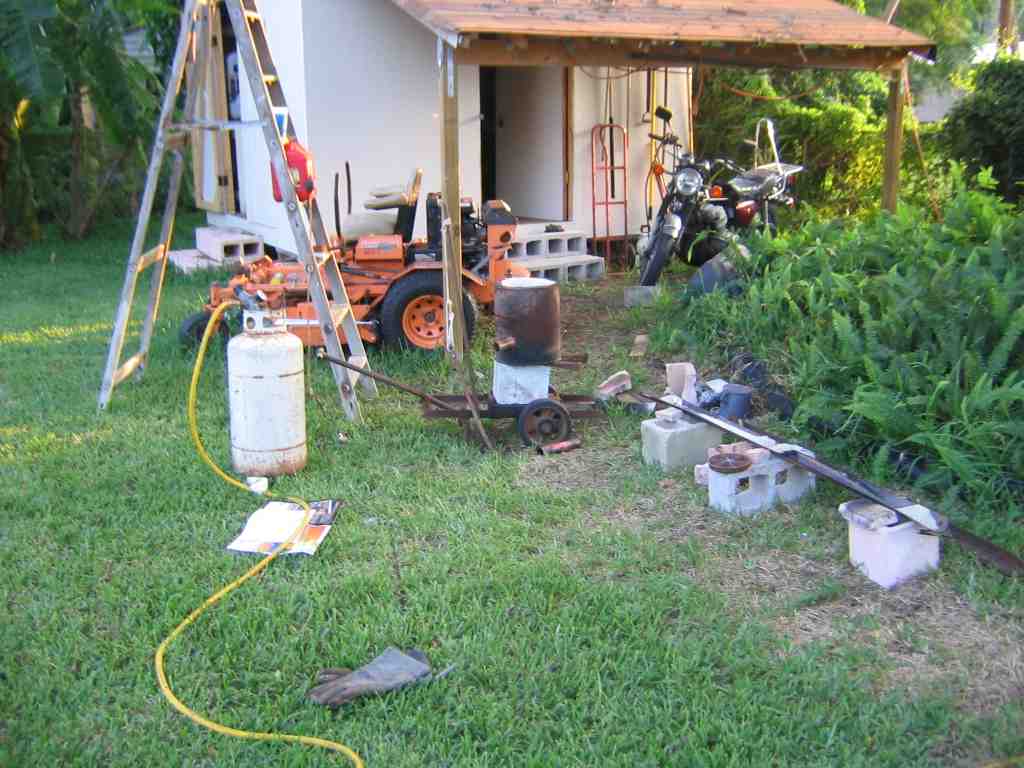
The last time I used the
furnace, I was experimenting with diesel fuel and a shop vac for air.
The fuel was dripping into the airflow and didn't atomize completely. I
was melting scrap using propane until the furnace was hot enough to
sustain the poorly atomized diesel fuel. Once it was going, though, it
burned very hot. I got carried away throwing Briggs & Stratton
engine cases into the furnace and plugged up everything with the
aluminum that missed the pipe crucible. Needless to say, I made a hell
of a mess out of the furnace. I was able to get the crucible out, but
had no place to pour it. It solidified as a full pot. The furnace was
clogged all the way up to the burner.
A few days later I turned the furnace up on it's side and fired it to melt the mess out. It was slow going until I removed the burner and tipped the furnace to a 45 degree angle and put the burner in the bottom, allowing the normal burner hole to act as the top vent. Luckily, it all came out with no damage to my 3000 degree refractory.
But I still had a pot full of cold aluminum and now was almost out of propane. I decided to try to burn diesel fuel from a cold start. To atomize the fuel better, I used an old spray paint gun as the nozzle. This is a Harbor Freight touch up gun. Here is their picture of it:
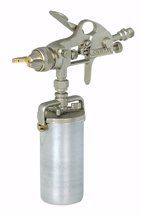
A few days later I turned the furnace up on it's side and fired it to melt the mess out. It was slow going until I removed the burner and tipped the furnace to a 45 degree angle and put the burner in the bottom, allowing the normal burner hole to act as the top vent. Luckily, it all came out with no damage to my 3000 degree refractory.
But I still had a pot full of cold aluminum and now was almost out of propane. I decided to try to burn diesel fuel from a cold start. To atomize the fuel better, I used an old spray paint gun as the nozzle. This is a Harbor Freight touch up gun. Here is their picture of it:

I Just looked and it is on
sale for $9.99 (Sept 17, 2006).
I have had this one for several years, but it nice to
know I can replace it this cheap.
I removed the paint cup and used a 1/4" pipe fitting to attach my needle valve & copper tubing. I used a large rubber band to hold the trigger.
The advantage to using this is the air and flow controls. I used a pressure regulator between my compressor and the paint gun-cum-nozzle.
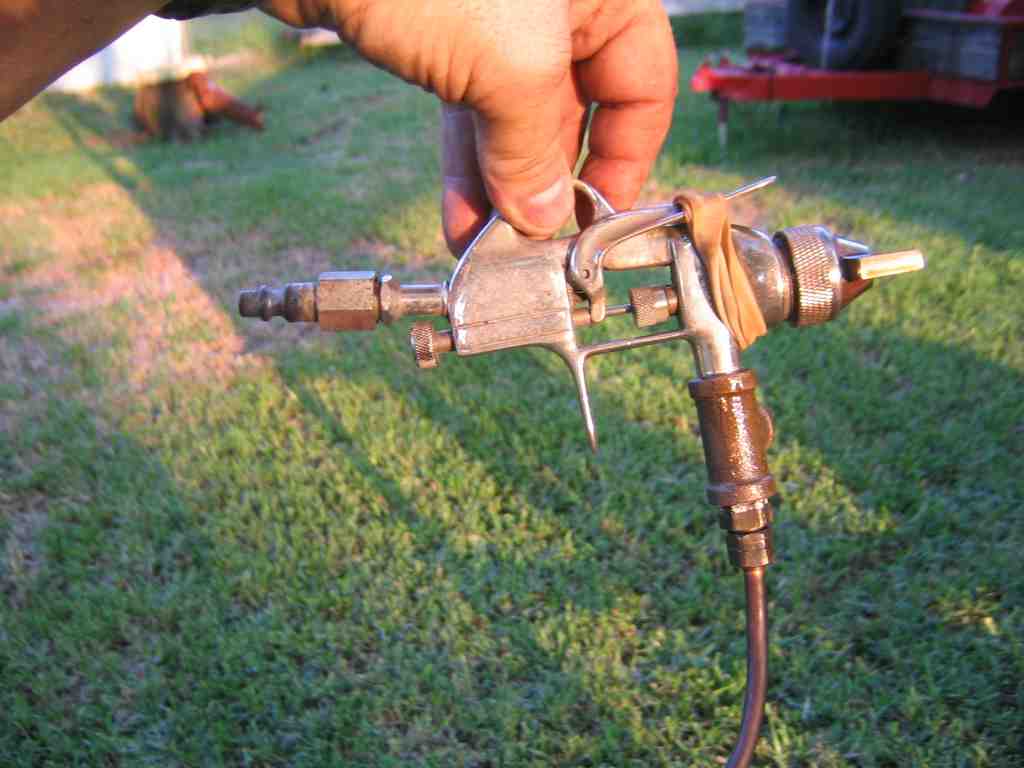
I removed the paint cup and used a 1/4" pipe fitting to attach my needle valve & copper tubing. I used a large rubber band to hold the trigger.
The advantage to using this is the air and flow controls. I used a pressure regulator between my compressor and the paint gun-cum-nozzle.

I wound up regulating the fuel
with my needle valve once I had the paint gun set where I wanted it,
and the air with the regulator.
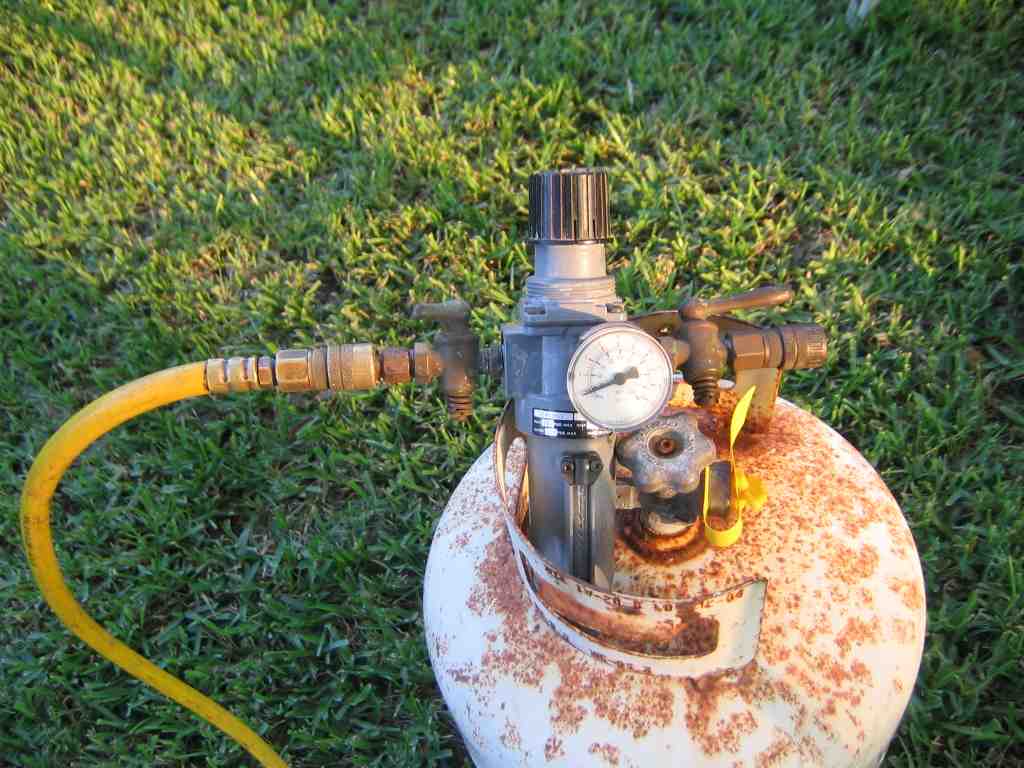

The propane tank was not used
so it stood duty as a stand to hold the regulator. In the shot below,
you can barely make out the needle valve in the copper tubing near
where the plastic tubing joins it.
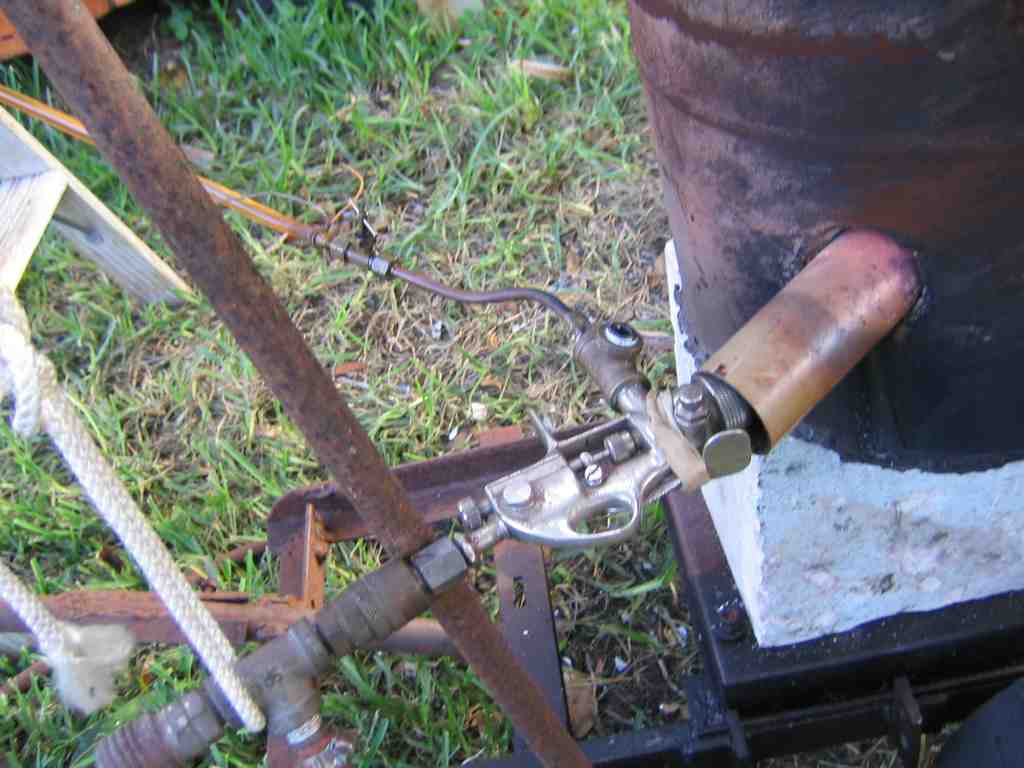

As you can see, I just stuck
the nozzle in the end of the "burner tube." Said burner tube is a
section of kids swing set the neighbor threw out. It is about 2" in
diameter and very thin wall. I started with a 9" long burner tube, but
the flame kept burning inside the tube so I cut a shorter one at around
5" and it did much better.
The nozzle left a little room to draw in outside air, but it didn't draw much. I could close off the space with my hands and it didn't seem to matter.
What did matter was having the drain hole open. My furnace has a large drain hole with 4 channels in the bottom refractory so spills can find their way out under the large plinth block. If I used the regular plinth, it cut off the air coming in the drain and killed the performance. The solution was to use three small pieces of concrete block to hold the crucible up off the bottom but still allow the air in. I was worried the concrete would crumble, but it held up long enough to pour. I intend to make new ones from refractory.

The nozzle left a little room to draw in outside air, but it didn't draw much. I could close off the space with my hands and it didn't seem to matter.
What did matter was having the drain hole open. My furnace has a large drain hole with 4 channels in the bottom refractory so spills can find their way out under the large plinth block. If I used the regular plinth, it cut off the air coming in the drain and killed the performance. The solution was to use three small pieces of concrete block to hold the crucible up off the bottom but still allow the air in. I was worried the concrete would crumble, but it held up long enough to pour. I intend to make new ones from refractory.

These photos were taken about
20 minutes after the pour, and I still can't get close with the camera.
The black around the outside is soot from the false starts. It was sooted all over, but once i got it going good, most of it burned off. I was lighting the furnace with wadded up paper, but when I turned on the air, it consumed the paper almost too fast to get the burner lit. I think and electric arc would be ideal, like they use on household oil gun burners.
The flame was very temperamental at first. I was starving it for fuel and air and didn't know it. It was very easy to blow out. And once out, I had to turn off the fuel to kill the smoke until I could relight it. Sometimes it sounded like a pulse jet, WRAP! Wrap! WRAP!, over and over.
Once I decided to quit pussy-footing around and opened the fuel and air to ridiculous amounts (or so it seemed at the time) the furnace came to life and roared. The pulse jet imitation was caused by insufficient air.
The diesel fuel was in a plastic gas can on the fourth step on my step ladder. I used rebar tie wire to make sure it stayed put. The free end of the wire was wrapped a few turns around the plastic tubing to hold it in firmly place. The black rubber bulb allows me to prime the line easily.

The black around the outside is soot from the false starts. It was sooted all over, but once i got it going good, most of it burned off. I was lighting the furnace with wadded up paper, but when I turned on the air, it consumed the paper almost too fast to get the burner lit. I think and electric arc would be ideal, like they use on household oil gun burners.
The flame was very temperamental at first. I was starving it for fuel and air and didn't know it. It was very easy to blow out. And once out, I had to turn off the fuel to kill the smoke until I could relight it. Sometimes it sounded like a pulse jet, WRAP! Wrap! WRAP!, over and over.
Once I decided to quit pussy-footing around and opened the fuel and air to ridiculous amounts (or so it seemed at the time) the furnace came to life and roared. The pulse jet imitation was caused by insufficient air.
The diesel fuel was in a plastic gas can on the fourth step on my step ladder. I used rebar tie wire to make sure it stayed put. The free end of the wire was wrapped a few turns around the plastic tubing to hold it in firmly place. The black rubber bulb allows me to prime the line easily.

This was sufficient head to
allow the burner to do well. And once it was hot, I didn't have any
more problems with it going out. I ran out of fuel, once, and it took
me a few minutes to remove the can, fill it and return it to it's
perch, but the furnace lit from the residual heat.
After it was burning well, I started doing other things and looking at it from time to time. There was ash from the paper on top of the aluminum in the crucible and it appeared solid, but on one look I noticed movement in the pot. I got the stir rod and poked at it. To my surprise it went to the bottom! the entire pot had melted and never disturbed to ash on top. That is when I noticed what caused the movement. It was boiling like water on the stove. I had never seen aluminum boil before. I wish I had a pyrometer! I would have liked to know how hot it was.
I hastily grabbed some old bed rails (angle iron) and put some K-Bond in it for dams and poured a couple of ingots.


After it was burning well, I started doing other things and looking at it from time to time. There was ash from the paper on top of the aluminum in the crucible and it appeared solid, but on one look I noticed movement in the pot. I got the stir rod and poked at it. To my surprise it went to the bottom! the entire pot had melted and never disturbed to ash on top. That is when I noticed what caused the movement. It was boiling like water on the stove. I had never seen aluminum boil before. I wish I had a pyrometer! I would have liked to know how hot it was.
I hastily grabbed some old bed rails (angle iron) and put some K-Bond in it for dams and poured a couple of ingots.


The aluminum doesn't look any
worse for the experience and made very good looking, shiny ingots.


*Added Later:
It was pointed out to me my someone on rec.crafts.metalworking that aluminum boils at about 2500° C. This works out to around 4500° F, a highly improbable number given the steel pot crucible. Most likely the bubbling was burning off an alloy or impurity or some sort.
It was pointed out to me my someone on rec.crafts.metalworking that aluminum boils at about 2500° C. This works out to around 4500° F, a highly improbable number given the steel pot crucible. Most likely the bubbling was burning off an alloy or impurity or some sort.